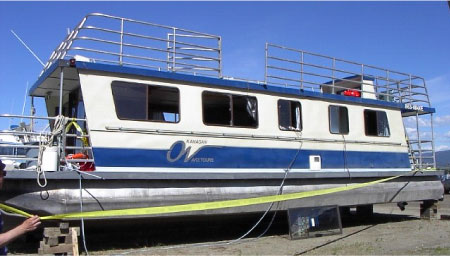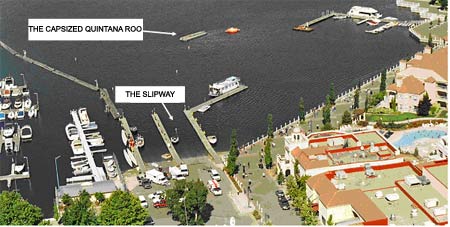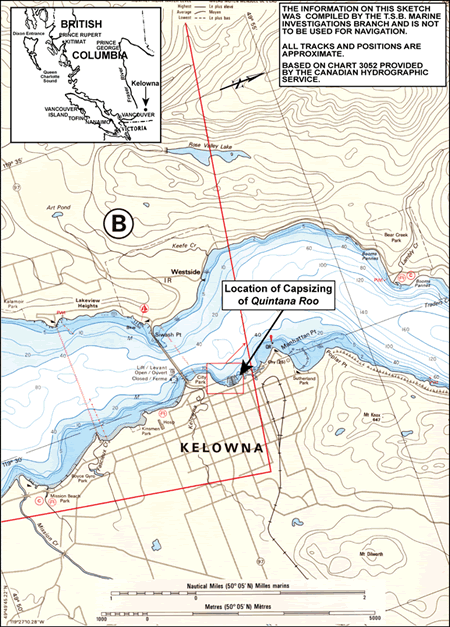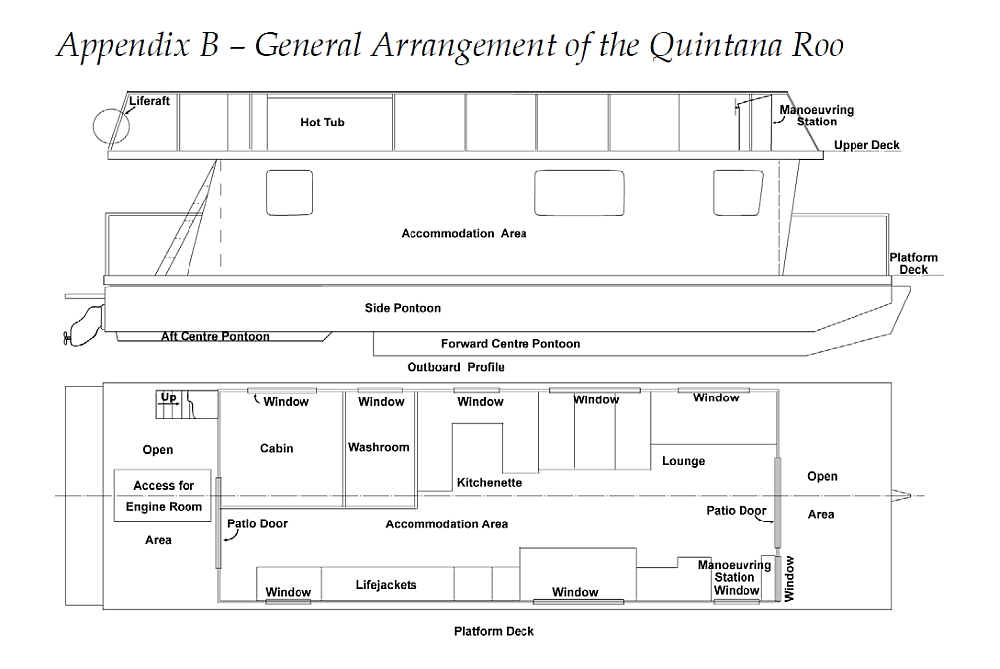Capsizing and loss of life
Pleasure craft Quintana Roo
Kelowna, British Columbia
The Transportation Safety Board of Canada (TSB) investigated this occurrence for the purpose of advancing transportation safety. It is not the function of the Board to assign fault or determine civil or criminal liability. This report is not created for use in the context of legal, disciplinary or other proceedings. See Ownership and use of content. Masculine pronouns and position titles may be used to signify all genders to comply with the Canadian Transportation Accident Investigation and Safety Board Act (S.C. 1989, c. 3).
Summary
At about 2250 on 08 June 2005, in good weather conditions, the rented pleasure craft Quintana Roo cast off from the public wharf at Kelowna, British Columbia, with a total of 61 persons on board: 55 on the upper deck, and 6 inside the lower accommodation area. Minutes after leaving its berth, the vessel listed to port and rapidly capsized. Many persons jumped or fell off and some, together with members of the public, helped to rescue those trapped inside. Some suffered minor injuries, and one person succumbed later, in hospital.
Factual information
Particulars of the vessel
| Name of vessel | "QUINTANA ROO" |
|---|---|
| Official number | 803883 |
| Port of registry | Edmonton, Alberta |
| Flag | Canada |
| Type | Pleasure craft (houseboat) |
| Gross tons | 24.14 |
| Length/breadth | 13.41 m/3.87 m |
| Built | 1983, Kelowna, British Columbia |
| Propulsion | One 90 kW, gasoline engine inboard/outboard drive, single fixed-pitch propeller |
| Crew | 2 |
| Other persons on board | 59 |
| Owner | Okanagan Waketours, Kelowna |
Description of the vessel
The Quintana Roo was designed and built in 1983 as a houseboat and was registered as a pleasure craft. The original design consisted of a flat, rectangular aluminium platform mounted atop two side pontoons. An additional centreline pontoon at the stern housed the engine, and the fuel, freshwater, and sewage tanks. A wooden superstructure forming the accommodation area was bolted atop the aluminium platform.
The accommodation area consisted of a lounge, kitchenette, washroom, and cabin. A manoeuvring station was located on this level at the starboard side of the forward end; it contained the steering wheel, engine controls, magnetic compass, and a radio. Aft, a small open area served as a stage for either ascending to the upper deck via a ladder, or for entering the accommodation. There was also a small open area forward (see Appendix B).
The open upper deck, also known as the sun deck, was surrounded by a 1 m high railing. A hot tub weighing approximately 1500 kg when full was located aft of midships, a 45-person liferaft was located at the stern, and a loudspeaker system weighing about 160 kg was located at the forward end. A second manoeuvring station was situated at the starboard forward end of the deck.
The pleasure craft was originally designed with a sleeper cabin on the upper deck. In 2002, the sleeper cabin was removed and the hot tub was added. Another centre pontoon, extending about two-thirds of the length of the pleasure craft from forward, was also fitted for additional buoyancy. Each pontoon had transverse divisions that formed watertight compartments.
A compartment located within the accommodation area contained standard-type lifejackets for 45 persons.
History of the voyage
The owners of the Quintana Roo rented the pleasure craft to a Kelowna resident (the renter) for the purpose of hosting his birthday party. The rental was to be for four hours from 2130 Pacific daylight timeFootnote 1 to 0130, on 08 June 2005, with the possibility of a 90-minute extension. Several days before the party, an estimated 25 to 30 persons were expected.
The task of organizing the party was taken over by two friends (the organizers), with final details confirmed by the renter on June 6. In addition to looking after the provision of beverages and entertainment, the organizers were also in charge of paying for the pleasure craft rental; although they were not seeking to make a profit, it was decided to defray overall expenses via an admission fee. One organizer was acquainted with two personsFootnote 2 who had handled the pleasure craft twice previously; he requested that they serve as crew, and the owners had no objection.
At about 2115 on June 8, the two-person crew brought the Quintana Roo from its marina to a public wharf at Kelowna, mooring it with two ropes forward and aft port side to the wharf, bow facing the shore.
The organizers boarded the pleasure craft around 2130 with a keg of beer, and together with the crew, they brought it to the upper deck. Terms of payment for the skipper and deckhand's services were settled at this time. The skipper informed the organizers that the pleasure craft's total capacity was 32 (including crew). As around 70 persons were by this point expected, it was decided that the vessel would make hourly return trips and that the persons would take turns aboard.
Persons began arriving at 2130, and the organizers collected admission monies. The crew, meanwhile, was working to fix problems previously experienced while steering the pleasure craft from the upper deck, in addition to performing other jobs on board.
By the time the renter arrived, at around 2200, the party was in full swing and 40 to 50 persons had assembled on board. By 2230, there were around 60 persons, the majority of whom were on the upper deck. The crew was still working below, busy getting the pleasure craft ready for the trip, and was not aware of the actual number of persons on board.
Between 2230 and 2245, one of the organizers informed the skipper that they were ready to leave. As the Quintana Roo was tied up facing the shore, it had to back out of the berth and turn around before sailing into the lake.
The skipper, who was in the lower control station, started the engine and left it idling. He then made his way to the upper deck and went through his pre-departure safety briefing. This covered the operation of the pleasure craft and precautions to be taken while on it, its public areas, safety features such as location of lifejackets, and any emergency procedures/action.
By this time, the persons had consumed beer and were noisy, and the skipper had trouble making himself heard. The large number of persons created confusion, and the skipper looked for the deckhand to see if a head count had been done, and if, as had been agreed previously, any excess persons were leaving.
At around this time, the deckhand was on the wharf. Two persons had taken it upon themselves to untie the mooring ropes and push the pleasure craft away from the wharf before jumping on board. The deckhand also jumped on and, realizing that the pleasure craft was in danger of striking the wharf on the other side of the slipway or of fouling on other objects, he called out for the skipper to back away.
Noticing that the ropes had been thrown into the water and not onto the pleasure craft, the deckhand warned the skipper that the stern rope could possibly foul the propeller, and told him not to engage the clutch. The skipper made his way aft through the persons and started down toward the deckhand, who by this time had pulled the rope from the water. Seeing this, and after getting an "all clear" signal from the deckhand, the skipper returned to the upper control station and began backing the Quintana Roo out of the slipway. At this point, there were 55 persons on the upper deck and 6 in the accommodation area.
Shortly after the Quintana Roo left the wharf, a powerboat came around the pleasure craft's stern. Seeing this, many of the persons subsequently moved toward the port side stern area of the upper deck. The pleasure craft, now trimmed by the stern, simultaneously heeled to port. The heel quickly became larger and, at around 2250, the vessel capsized. The persons on the upper deck either jumped or fell into the water and then swam clear. All but one of those in the accommodation area either found the forward and after doorways and swam out that way, or else opened windows to escape.
At the time of the occurrence, two parties of firefighters were having dinner on the patio at a pub about 100 m away. Seeing the pleasure craft capsize, they immediately dove in and pulled people from the water. One person was trapped in the washroom when the pleasure craft capsized. After being rescued, she was rushed to hospital, but died a few hours later. Other swimmers made their way to shore or to a nearby houseboat, which had been untied and floated out toward the Quintana Roo to serve as a platform for persons to cling to.
Rescue and ambulance services were summoned, arriving at about 2315.
Joint Rescue Coordination Centre (JRCC), Victoria, British Columbia, was contacted, and search and rescue (SAR) Cormorant helicopters and the Royal Canadian Mounted Police (RCMP) dive team from Nanaimo, British Columbia, were tasked to search for anyone trapped inside the pleasure craft. The team arrived at about 0100 on June 9 and commenced a search, but found no one.
The vessel was later righted and lifted ashore.
Injuries to persons
The survivors were counted, identified, and taken by bus to a local fire hall, where they were treated for mild hypothermia and some minor cuts and bruises. One survivor had a dislocated shoulder; another, who was rushed to the hospital after being rescued, died a few hours later.
Environmental conditions
At the time of the occurrence, there was no wind, skies were clear and the air temperature was around 10°C. For June, the average surface water temperature in Okanagan Lake is 14°C.
Vessel stability/capacity
An assessment of the pleasure craft's intact transverse stability was carried out by the TSB, based on the reported loading condition at the time of the occurrence. For this assessment, the pleasure craft's lightship condition was established by referring to the scum line on the pontoons. Various loading conditions were simulated to show the effect of different numbers and locations of persons on the pleasure craft's stability.
The results of the stability assessment show that, in the departure condition and with the number of persons described previously, the reserve buoyancy was about 50 per cent of the displacement. The current standard for small passenger vessels of this type is 100 per cent of the displacement.Footnote 3 With persons "evenly" distributed, the pleasure craft had some measure of positive stability; however, with an "uneven" distribution, the pleasure craft would capsize. Only a reduction in the number of persons to about 35 (regardless of distribution) would bring a return to positive stability.
The pleasure craft did not have a capacity plate indicating the maximum number of persons (or maximum load) allowed on board nor was it required by the regulations.Footnote 4 Furthermore, there was no manufacturer's recommendation for maximum capacity. However, in July 2002, when the owners were considering commercial operation and further to a stability test, Transport Canada (TC) determined that a maximum of 27 persons (25 plus 2 crew) could be on board according to commercial vessel standards. Following the addition of a second centre pontoon, the owner increased this maximum to 32.
In TC's sample Rental Boat Safety ChecklistFootnote 5 (see Appendix C), an operator is required to confirm "that the maximum load capacity and number of persons in the pleasure craft will not exceed the amount stated on the capacity plate." The checklist continues: "If a capacity plate is not fitted, the load capacity and number of persons in the pleasure craft shall not exceed the manufacturer's recommendation." In this case, the checklist was not completed; however, the maximum number of persons was agreed upon before the voyage.
Houseboat rentals
A significant houseboat rental trade flourishes in Canadian lakes and rivers during the summer season. On Okanagan Lake, British Columbia, the rental periods can vary from an hour to a day, but rarely extend overnight due to water depth and absence of suitable places to anchor; boats rented from Kelowna remain in the vicinity.
Tourists make up the bulk of renters, but boats are also rented out for business conferences and private parties. Under the Canada Shipping Act, a rented houseboat such as the Quintana Roo is considered to be a pleasure craft, and is registered as such.
In this case, the renter and the organizers arranged for crew and payment to the owners, similar to the requirements of a "bare-boat charter."Footnote 6 The purpose of the trip was pleasure, with no intent for profit; simply sharing of or participation toward expenses. There was no signed contractual agreement.
Regulatory agencies
TC provides inspection services and regulatory advice to commercial vessel and ferry owners in the area. TC also ensures that houseboat rental companies do not violate the definitions of "pleasure craft" and "passengers" and, consequently, the houseboats remain non-commercial entities as defined by Ship Safety Bulletin 14/2000 and TP 13699. TC's Office of Boating Safety is responsible for administering the regulations and programs relating to pleasure craft.
An initial attempt was made by the owners of the vessel to bring the vessel up to the standard required for passenger vessels. Such efforts ceased in 2002 and the vessel was not issued with an inspection certificate.
Personnel certification and experience
In this instance, neither the skipper nor the deckhand had any formal marine qualifications or certification, nor was such certification required. The skipper had held this position on two previous occasions.
Under the Competency of Operators of Pleasure Craft Regulations, the skipper was not required to have proof of competency since the pleasure craft was more than 4 m in length. However, by 15 September 2009, the skipper will have to acquire proof of competency.
Analysis
Vessel stability
The pleasure craft was rendered unstable by the presence of 55 persons unevenly distributed on the upper deck. This instability became critical during the departure, at which time the heeling moment created by the movement of persons to the port aft side was not compensated for by an equal balancing righting moment. This allowed the pleasure craft to continue its heel to port until it capsized.
Number of persons aboard
The renter, the organizers, and the skipper were all aware of the pleasure craft's limit of 32 persons, which had been set by the owners. Further, it had been agreed to make hourly trips so as to stay in compliance with this limit. However, no control was exercised over the number of persons boarding the pleasure craft, and consequently the vessel was overloaded.
Maximum capacity
The Small Vessel Regulations, for pleasure craft not over 6 m in length, requires that a capacity plate, or single vessel plate, be permanently affixed to the craft and in a conspicuous position plainly visible from the helm, indicating the maximum number of occupants. Craft such as the Quintana Roo are outside that prescription, and are not required to determine or display maximum load capacity. This puts at risk any persons making use of pleasure craft greater than 6 m in length, particularly novice boaters or first-time renters who would benefit from such information.
Findings
Findings as to causes and contributing factors
- No control was exercised over the number of persons boarding the pleasure craft, causing the vessel to be overloaded.
- Too many persons, unevenly distributed on the upper deck, rendered the pleasure craft unstable.
- The pleasure craft capsized when there was no compensation for the heeling moment created by the movement of persons to the port aft side of the upper deck.
Findings as to risk
- The lack of a requirement to display the pleasure craft's maximum load/capacity on pleasure craft exceeding 6 m in length puts vessels and persons at risk, particularly novice boaters or first-time renters who would benefit from this information.
Safety action
Safety concern
In Transport Canada's sample Rental Boat Safety ChecklistFootnote 7 (see Appendix C), an operator is required to confirm "that the maximum load capacity and number of persons in the pleasure craft will not exceed the amount stated on the capacity plate." The checklist continues: "If a capacity plate is not fitted, the load capacity and number of persons in the pleasure craft shall not exceed the manufacturer's recommendation."
While the owner, the renter, the organizers, and the skipper in this occurrence were all aware that the owner's maximum limit of persons aboard was 32, in the absence of capacity plates, renters of other pleasure craft over 6 m in length may not have this information.
The Small Vessel Regulations require that, for pleasure craft not over 6 m in length, a capacity plate, or single vessel plate, be permanently affixed to the craft and in a conspicuous position plainly visible from the helm, indicating the maximum number of occupants. Craft such as the Quintana Roo are outside this requirement and do not need to determine or display maximum load capacity.
The Board is therefore concerned that this puts at risk persons making use of pleasure craft greater than 6 m in length, particularly novice boaters or first-time renters who would most benefit from such information.
This report concludes the Transportation Safety Board's investigation into this occurrence. Consequently, the Board authorized the release of this report on .
Appendices
Appendix A - Map of the occurrence area
Appendix B – General arrangement of the Quintana Roo
Appendix C - Sample rental boat safety checklist
Source: Transport Canada's Office of Boating Safety
PLEASE INITIAL EACH BOX ON THE FORM AS THE SUBJECT IS COVERED BY THE RENTAL OPERATOR/OUTFITTER
BOATING SAFETY RULES
-
I, the pleasure craft operator, confirm that there are the appropriate number and sizes of approved Personal Floatation Devices or Life Jackets in the boat for the number of people on board. They must fit and should be worn. I am aware that persons operating a pleasure craft without the appropriate number and sizes of approved Personal Floatation Devices or Life Jackets may be subject to ticketing and a fine.
-
I, the pleasure craft operator, am aware that it is illegal to operate a pleasure craft, or to permit others to do so, when under the influence of alcohol, narcotics, or barbiturates.
-
I, the pleasure craft operator, will only allow people who have completed and signed a Rental Boat Safety Check List, valid for the duration of this rental or have other proof of competency, to operate this pleasure craft. I am aware that persons operating a pleasure craft without proof of competency/age may be subject to ticketing and a fine.
-
I, the pleasure craft operator, have been shown how to use, and know the location of safety equipment required under the Small Vessel Regulations. I am aware that persons operating a pleasure craft without the required safety equipment may be subject to ticketing and a fine.
-
I, the pleasure craft operator, understand that pleasure craft fitted with motors must keep clear of non-powered pleasure craft. I also understand that I am responsible for my own wake and wash and the effects that it can have on other pleasure craft, property, wildlife and the environment.
-
I, the pleasure craft operator, when involved in an accident must stop, offer assistance and give my identity.
OPERATION OF THE BOAT
-
I, the pleasure craft operator, am aware of how to responsibly operate a pleasure craft and to share waterways in a courteous and respectful manner with others involved in all water-related activities.
-
I, the pleasure craft operator, confirm that the maximum load capacity and number of persons in the pleasure craft will not exceed the amount stated on the capacity plate. If a capacity plate is not fitted, the load capacity and number of persons in the pleasure craft shall not exceed the manufacturer's recommendation. I am aware of the proper way to distribute weight in the pleasure craft for a safe and comfortable ride and I will keep my passengers in the safest positions at all times - always seated while underway.
-
I, the pleasure craft operator, have been shown the proper procedure for starting and shutting off the engine and will make sure no person is in the water within the vicinity of the pleasure craft before starting and while running the motor.
-
I, the pleasure craft operator, have been shown and understand the operation of the throttle and gear-shift lever.
-
I, the pleasure craft operator, know where and how to operate the ignition cut-off (kill) switch. While operating a Personal Water Craft, I will stay tethered to it at all times.
-
I, the pleasure craft operator, am aware of how to depart and approach the dock in a safe and proper manner.
-
I, the pleasure craft operator, am aware of how to respond to grounding, capsizing, and re-boarding.
LOCAL HAZARDS AND CONDITIONS
-
I, the pleasure craft operator, am aware of the local navigational aids and their meaning, as well as local hazards and local regulations.
-
I, the pleasure craft operator, shall maintain a proper lookout at all times for other boats, navigational hazards and changes in weather conditions - changes in weather can occur quickly creating conditions dangerous to recreational boats.



